|
|
|
Archive for the 'Reviews & Recommendations' Category
Thursday, October 23rd, 2008
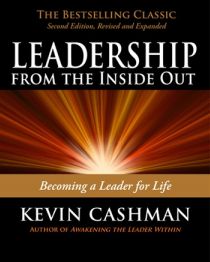 Leadership From The Inside Out: Becoming a Leader for Life is a second edition, published on the 10th anniversary of the original. Leadership From The Inside Out: Becoming a Leader for Life is a second edition, published on the 10th anniversary of the original.
What Kevin Cashman writes resonates whether you’re running a Fortune 100 corporation, raising a kid, or struggling to live a decent life.
As Cashman reminds us immediately, “we are the CEO’s of our own lives,” so if you read the book forgetting what you do or what you earn and focus on increasing your value to YOURSELF and those around you the book has great value.
However, if you read it as another part of a to-do list on getting ahead its value substantially declines.
Leadership From The Inside Out addresses understanding, growth and change in your MAP (mindset, attitude, philosophy™) as opposed to a set of steps and check-off points in how to be a ‘leader’.
Unhappily for some, Leadership From The Inside Out requires you to not only think, but think deeply. To gain real benefits from it you’ll need to mull, cogitate and then enable change in many levels of your MAP. Doing so is neither easy nor comfortable, but it is personally rewarding and extraordinarily valuable.
The book is still more valuable if you recast some of the thoughts to broaden its scope, e.g., where Cashman asks how authentic you are as a ‘leader’, ask yourself instead how authentic you are as a human being? How authentic in your other roles—parent, friend, spouse, teacher, landlord, plumber, etc.
The book is divided into seven ‘masteries’, they are
- personal mastery;
- purpose mastery;
- change mastery;
- interpersonal mastery;
- being mastery;
- balance mastery; and
- action mastery.
Cashman focuses on the fact that it’s not enough for you to master each of these, but that you must share them—passing them on to others within your world.
Although the book talks about executives, it’s not difficult to extend the intelligence to any level along with every-day life.
You always have to lead yourself, and you never know when you’ll have the opportunity to lead others, which makes the effort involved in truly utilizing what Cashman offers well worthwhile.
~~~~~~~~~~~~~~~~~~~~~~~~~
CandidProf’s schedule requires reducing posts to every other week. Read all of CandidProf here.
Your comments—priceless
Don’t miss a post, subscribe via RSS or EMAIL
Image credit
Posted in About Leadership, Change, Communication, Entrepreneurship, Leadership Choice, Leadership Resources, Leadership Skills, Personal Development, Reviews & Recommendations, What Leaders DO | 3 Comments »
Friday, September 5th, 2008
Image credit: jimrhoda CC license
 In case you hadn’t noticed, for CEOs, AKA, leaders, times ain’t what they used to be. In case you hadn’t noticed, for CEOs, AKA, leaders, times ain’t what they used to be.
Not long ago, CEOs were powerful autocrats running top-down organizations under the auspices of Boards comprised friends and colleagues—but not any more.
Life as a CEO has changed drastically as reported in a fascinating book by Alan Murray, the Wall Street Journal’s executive editor for online, Revolt in the Boardroom: The New Rules of Power in Corporate America . (Excerpt) . (Excerpt)
Is the turnover tally really that large; that different from what it used to be?
I’m sure there must have been an exception here and there, but prior to the 1990s CEOs weren’t fired. During the Nineties Boards ousted a few high profile cases, such as GM, IBM, American Express, but by mid-2000 things really started changing and have continued apace—663 in 2004, 1322 in 2005, 1478 in 2006, but ‘only’ 1,356 2007.
Of course, not all were fired, some retired, some took outside offers, but a great number left by, or just before, Board request and some left in a very public perp walk.
Read the book, it’s educational, entertaining and will change your view of the corner office.
Posted in Business info, Culture, Leadership, Retention, Reviews & Recommendations | No Comments »
Friday, August 22nd, 2008
 Books on leadership, management and associated subjects abound. Jim Stroup has a great post on the dangers of buying into the books written by academics. Jim points out that many academics do do valuable work, Books on leadership, management and associated subjects abound. Jim Stroup has a great post on the dangers of buying into the books written by academics. Jim points out that many academics do do valuable work,
“But when you pick up a book by an academic, look for a sense that the author feels he or she is examining a species of being (you and me) that is not meaningfully self-aware. Such an author may interact with us while conducting research, but will not assign any validity to our own assessments of what we do or why. We are expected to cede that to him (or her), the scholarly expert, whose role it is understand and explain. Ours is merely to learn as best we can, sufficient to be able to comply with the scientific prescription for our suffering – and that with submissiveness and gratitude… Do not let yourself become vulnerable to an academic coup. Keep the scholars in the campus.”
Although I agree that countless academics have taken this approach over the years, I find the attitude not that much different from many of the business “leaders,” consultants, and gurus (self-proclaimed or otherwise) who write how-to and how-I-did-it books.
There are a few gold nuggets in almost everything written, but there are no silver bullets.
And, valuable as it is, reading takes time, so your goal should be to find the highest value for the lowest time/energy cost, which means that reviews and referrals are a good way to go.
But you need to keep certain things in mind,
- nothing will have value if it isn’t at least synergistic with your MAP (mindset, attitude, philosophy™)
- consider the source of a referral or review first;
- Google the book and read several reviews;
- remember that reviewers review through the prism of their own MAP; so
- trust your MAP and your reactions to what you hear/read.
Finally, never forget that you don’t have to finish a book you start—I promise that no thunderbolt will strike. If the book is a chore to read it’s unlikely that you will derive enough value to warrant the cost of reading it.
Please! Share your favorite business books here.
Your comments—priceless
Don’t miss a post, subscribe via RSS or EMAIL
Image credit: gabrielayb CC license
Posted in About Leadership, Communication, Reviews & Recommendations | 4 Comments »
Thursday, June 12th, 2008
A couple of decades (give or take) ago Terry Dial, who eventually became vice chairman of Business Banking at Wells Fargo, told me that “People are 90% of our costs as well as the key to customer service and satisfaction. The only thing that should take priority over hiring a new employee is keeping a current one.”
Wise woman, Terry, and way ahead of her time.
Now comes another wise woman via Phil Gerbyshak’s interview with Sybil Stershic at Slacker Manager.
 Stershic’s written a book called Taking Care of the People Who matter most: A Guide to Employee Customer Care. The meaning of the title hits the nail on the head, “It’s based on the impact employees have on customers; namely, the way your employees feel is the way your customers will feel. And if your employees don’t feel valued, neither will your customers!” Stershic’s written a book called Taking Care of the People Who matter most: A Guide to Employee Customer Care. The meaning of the title hits the nail on the head, “It’s based on the impact employees have on customers; namely, the way your employees feel is the way your customers will feel. And if your employees don’t feel valued, neither will your customers!”
Is it true? Does it work? Tony Hsieh built Zappos on this principle.
Read the interview (Phil is always worth reading) and at the end you’ll find a great deal on the book.
What do you do to take care of your people?
Image credit: Windsor Media
Posted in Communication, Culture, Hiring, Motivation, Retention, Reviews & Recommendations | 2 Comments »
Monday, June 9th, 2008
More than 30 years ago I noticed that people seemed to have two sides of their brain—personal and professional—and they rarely utilized the knowledge from one side to address situations on the other. One way that the two areas were kept separate was with language—different terms for what were essentially the same thing. This was especially true about their human interactions.
Many people attended “relationship workshops” on the weekend, but rarely thought to take what they learned to work on Monday because those were colleagues—not relationships.
But that was then and this is now.
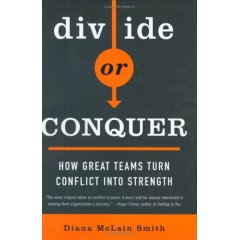 These days relationships are recognized as business lifeblood and everyone works to improve them, so Diana McLain Smith’s Divide or Conquer: How Great Teams Turn Conflict into Strength These days relationships are recognized as business lifeblood and everyone works to improve them, so Diana McLain Smith’s Divide or Conquer: How Great Teams Turn Conflict into Strength is right on the money. is right on the money.
Smith says that all teams “rise or fall on the strength of their relationships,” but instead of the typical discussion of team relationships, strengths, etc., she draws on her 25 years of experience and analyzes a number of high profile relationships to graphically illustrate her points.
She shows us why our belief that the problem is the other guy’s attitude/action and focusing on getting him to change boomerangs convincing the team that the source of the problem is actually us.
Smith says that what must change is how we interact, i.e., change the old patterns and create new ones, explaining how to build work relationships that are flexible and strong—the kind that can survive the tough challenges found in today’s global economy.
She takes you behind the media stories of relationships that made headlines, such as the recruitment and eventual meltdown of Steve Jobs and John Sculley, to illustrate how a broken relationship can cause severe damage not just to the people, but to the company and the brand.
Relationships happen, but great relationships take thought and effort. They’ll never be easy, but Divide or Conquer provides the tools and insights to make them easiER.
What did you think of the book?
Image credit: Wesman PR
Posted in About Leadership, Culture, management, Personal Development, Reviews & Recommendations | 7 Comments »
Thursday, April 24th, 2008
Bridget from Biz Chicks Rule was surprised that I don’t consider politicians leaders since “they tell us their vision and lay a path of guidance to show how we’re going to get there?”
To me, the ability to articulate a vision and describe a path a leader does not make.
 My idea of a leader is about 2500 years old and comes from Lao Tzu’s Tao Te Ching My idea of a leader is about 2500 years old and comes from Lao Tzu’s Tao Te Ching . .
As for the best leaders,
the people do not notice their existence…
When the best leader’s work is done,
the people say, “We did it ourselves!”
To lead the people, walk behind them.
Be gentle and you can be bold; be frugal and you can be liberal; avoid putting yourself before others and you can become a leader among men.
The superior leader gets things done with very little motion. He imparts instruction not through many words but through a few deeds. He keeps informed about everything but interferes hardly at all. He is a catalyst, and though things would not get done well if he weren’t there, when they succeed he takes no credit. And because he takes no credit, credit never leaves him.
Do you know of a politician who fits these descriptions.
Your comments—priceless
Image credit: jensimon7
Posted in About Leadership, Leadership Quotes, Leadership Skills, Personal Development, Politics, Reviews & Recommendations | 4 Comments »
Thursday, April 24th, 2008
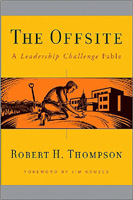 Much of the best leadership advice is classic and often lays the groundwork for more modern interpretations. This isn’t always good, but it certainly works in The Offsite Much of the best leadership advice is classic and often lays the groundwork for more modern interpretations. This isn’t always good, but it certainly works in The Offsite , which bills itself as A Leadership Challenge Fable. , which bills itself as A Leadership Challenge Fable.
In it, Robert H. Thompson presents the philosophy taught in Jim Kouzes’ and Barry Posner’s 1987 The Leadership Challenge , which defined the 5 Practices of Leadership as , which defined the 5 Practices of Leadership as
- Model the Way
- Inspire a Shared Vision
- Challenge the Process
- Enable Others to Act
- Encourage the Heart
So why read Thompson’s book?
Because in a short 200 pages, Thompson takes you to a company’s offsite meeting, filled with people you know (including yourself), to help you to understand that everyone’s is/can/should be a leader.
It proves in a relatable way that leadership isn’t about position. And, most importantly, drives home the fact that it’s not what you do but how you think that counts—leadership isn’t a set of actions it’s who you are.
I highly recommend The Offsite for those at the start of their business lives as well as for those further along the path. It’s fun; it’s painless; and it will make a difference.
I hope you’ll share your opinions after you’ve read it.
Your comments—priceless
Don’t miss a post, subscribe via RSS or EMAIL
Posted in About Leadership, Communication, Culture, Personal Development, Reviews & Recommendations | 1 Comment »
Monday, April 21st, 2008
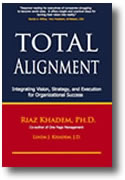 Riaz Khadem’s Total Alignment: Integrating vision, strategy and execution for organizational success Riaz Khadem’s Total Alignment: Integrating vision, strategy and execution for organizational success is scary. It’s scary for three reasons is scary. It’s scary for three reasons
- the entire book makes perfect sense;
- the approaches and solutions it offers are devastatingly simple; and
- it’s a fast (just 150 pages), fun read—not always the case with business books.
Its focus is larger companies, although young companies that are planning on substantial growth can benefit from implementing the structures described when appropriate.
But the great difference is that Total Alignment is written as a story, complete with a hero and a villain and a guru. It’s fast paced, weaving the needed how-to’s into the story, showing how they work, how to draw people in, including the skeptics, and the results from implementing the ideas and philosophy presented.
No smoke, no mirrors.
In the end, it takes the thoughtful CEO to a new vision, one beyond the usual thinking and beyond just the success of his company.
“Total Alignment is aligning the [corporate] vision itself with the urgent needs of humanity.”
Once a company is completely aligned internally then true total alignment is achieved by “making a positive contribution to the local, national, and world community while maintaining the company’s financial and operational advantages.”
For those of you who aren’t in agreement with business’ social responsibility fear not, it’s only brought up on the last three pages and you can easily skip them.
Please add your thoughts on Total Alignment now or come back and do so when you’ve read it.
Image credit: Infotrac
Posted in Business info, Reviews & Recommendations | 1 Comment »
Friday, March 14th, 2008
It’s not that we can’t learn from the business advice and management practice flavors du jour, but it’s useful to revisit the basics, especially when they’re presented in an enjoyable, easy-to-read format by someone who isn’t into writing by the pound.
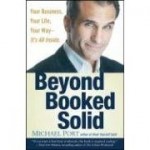 Focused on professionals and solopreneurs, Michael Port’s soon-to-be-released Beyond Booked Solid: Your Life, Your Way–It’s All Inside starts where Booked Solid ends by offering a sensible, flexible roadmap for expanding your business further without killing yourself. Focused on professionals and solopreneurs, Michael Port’s soon-to-be-released Beyond Booked Solid: Your Life, Your Way–It’s All Inside starts where Booked Solid ends by offering a sensible, flexible roadmap for expanding your business further without killing yourself.
And if reading Michael doesn’t convince you that the work/life answers you crave are found internally—not provided by external agents or floating like dandelion fluff in the air—then probably nothing will.
Beyond Booked Solid puts you on the road to personal innovation—showing you how to do more, work less, and make sure that the ‘do more’ is stuff you like doing.
Although the book offers excellent philosophical insights (including many ‘oops, forgot about that’ moments) it moves beyond that by providing the tools, including strategies, techniques, tips and resources, to turn the philosophy into reality.
Port’s comment, “…working on your business, while working in your business, while working on yourself,” pretty much sums up not just how you should earn your living, but how you live your life and grow. I can easily paraphrase that as, “Working on your life, while living in your life, while working on yourself.”
One last point. Beyond Booked Solid, like Booked Solid, is grounded in Port’s genuine desire to really help, not just sell books, so he also provides readers with another free, comprehensive, downloadable companion workbook.
What more can you ask?
Posted in Personal Development, Reviews & Recommendations | No Comments »
Friday, February 29th, 2008
 Justin Menkes’ Executive Intelligence: What All Great Leaders Have Justin Menkes’ Executive Intelligence: What All Great Leaders Have shines a hard light on what sets executives apart. Why does one show brilliant insight while another moves at normal levels and yet another badly blows it? shines a hard light on what sets executives apart. Why does one show brilliant insight while another moves at normal levels and yet another badly blows it?
Menkes makes a case that it is intelligence and the resulting cognitive skills that underlie the brilliance seen in executives such as Andrea Jung (Avon Products Inc.), Van Johnson (Sutter Health) and Jack Welch, as opposed to so-called emotional intelligence or charisma.
Menkes idea that it is intelligence that makes the difference is based on eight years of research on intelligence tests and cognitive skills and reveals the set of aptitudes that all brilliant leaders share.
Although 50% of an individual’s intellectual capacity is genetically influenced, Menkes makes the point that the remaining half offers fertile ground for teaching and improving Executive Intelligence. (He cites several studies showing the difference in test scores between students participating in interactive classes that stress critical thinking vs. more typical teaching methods that do well regurgitating information for standardized tests.)
Menkes breaks managerial work down into three areas—accomplishing tasks, working with other people, and self-evaluation—then identifies the cognitive skills that determine how well an executive performs.
- Tasks – to correctly define a problem, identify the highest-priority issues, assess what is known and determine needs to be known in order to render a sound decision.
- Others – to recognize underlying agendas, understand multiple perspectives, and anticipate likely emotional reactions throughout the organization.
- Self – to objectively identify one’s own mistakes, encourage and seek out constructive criticism, and adjust one’s own behavior.
Much of the book relates to how important evaluating intelligence is when hiring and includes discussions with CEOs on their approach to recognizing its presence.
Menkes believes the best way evaluate a candidate’s talent and cognitive skills is found in a set of question that discuss hypothetical business problems, since this most closely mimics the way most business decisions are actually made.
Additionally, that the best tests in hiring measure the ability to accomplish tasks, work with and through others, evaluate oneself and adapt accordingly and he defines 17 critical skills that the best managers use to think their way through problems.
There is much food for thought in Executive Intelligence, but I was sadly disappointed at the lack of concrete how-to’s.
I realize that Menkes heads Executive Intelligence Group, a consulting firm whose revenues are based on providing the questions and other how-to information for it’s clients, but the lack of practical help in applying his excellent research left me with the feeling that the only solution was to hire his company—something completely our of reach to many companies and most startups.
What roll do you think intelligence plays in running a business?
Posted in About Leadership, Leadership Resources, Leadership Skills, Reviews & Recommendations | 1 Comment »
|
 Subscribe to
Subscribe to
MAPping Company Success
About Miki 
Clarify your exec summary, website, etc.
Have a quick question or just want to chat? Feel free to write or call me at 360.335.8054
The 12 Ingredients of a Fillable Req
CheatSheet for InterviewERS
CheatSheet for InterviewEEs™
Give your mind a rest. Here are 4 quick ways to get rid of kinks, break a logjam or juice your creativity!
Creative mousing
Bubblewrap!
Animal innovation
Brain teaser
The latest disaster is here at home; donate to the East Coast recovery efforts now!
Text REDCROSS to 90999 to make a $10 donation or call 00.733.2767. $10 really really does make a difference and you'll never miss it.
And always donate what you can whenever you can
The following accept cash and in-kind donations: Doctors Without Borders, UNICEF, Red Cross, World Food Program, Save the Children
*/
?>About Miki
About KG
Clarify your exec summary, website, marketing collateral, etc.
Have a question or just want to chat @ no cost? Feel free to write
Download useful assistance now.
Entrepreneurs face difficulties that are hard for most people to imagine, let alone understand. You can find anonymous help and connections that do understand at 7 cups of tea.
Crises never end.
$10 really does make a difference and you’ll never miss it,
while $10 a month has exponential power.
Always donate what you can whenever you can.
The following accept cash and in-kind donations:
|
 Leadership From The Inside Out: Becoming a Leader for Life is a second edition, published on the 10th anniversary of the original.
Leadership From The Inside Out: Becoming a Leader for Life is a second edition, published on the 10th anniversary of the original.



 In case you hadn’t noticed, for CEOs, AKA, leaders, times ain’t what they used to be.
In case you hadn’t noticed, for CEOs, AKA, leaders, times ain’t what they used to be. Books on leadership, management and associated subjects abound. Jim Stroup has a
Books on leadership, management and associated subjects abound. Jim Stroup has a  Stershic’s written a book called
Stershic’s written a book called  These days relationships are recognized as business lifeblood and everyone works to improve them, so Diana McLain Smith’s
These days relationships are recognized as business lifeblood and everyone works to improve them, so Diana McLain Smith’s  My idea of a leader is about 2500 years old and comes from Lao Tzu’s
My idea of a leader is about 2500 years old and comes from Lao Tzu’s  Much of the best leadership advice is classic and often lays the groundwork for more modern interpretations. This isn’t always good, but it certainly works in
Much of the best leadership advice is classic and often lays the groundwork for more modern interpretations. This isn’t always good, but it certainly works in  Riaz Khadem’s
Riaz Khadem’s  Focused on professionals and solopreneurs, Michael Port’s soon-to-be-released
Focused on professionals and solopreneurs, Michael Port’s soon-to-be-released  Justin Menkes’
Justin Menkes’ 
